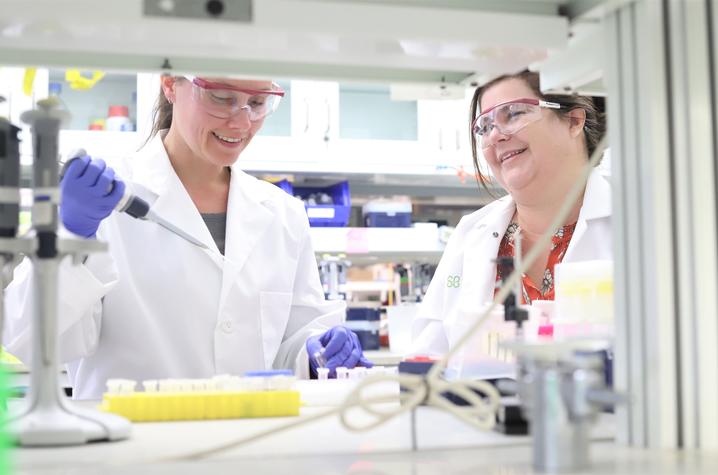Tiny antibodies hold big promise for cancer treatment

Using antibodies derived from alpacas, a University of Kentucky research team has developed a tool that could lead to new therapies to stop the growth of several types of cancer.
While cancer researchers have known that a protein called PRL-3 is linked to the growth of colon, breast, lung, skin and blood cancers, there is little understanding about how it works due to a lack of tools to study it effectively.
With unique alpaca antibodies known as nanobodies, the team led by UK Markey Cancer Center researcher Jessica Blackburn, Ph.D., developed the first effective tool to specifically target PRL-3.
The discovery brings scientists one step closer to developing a drug that can stop the expression of PRL-3 and the growth of cancer, says Blackburn.
“The nanobodies are valuable new tools that can help researchers better understand how PRL-3 contributes to cancer progression,” said Blackburn, an associate professor in the UK College of Medicine’s Department of Molecular and Cellular Biochemistry. “Ultimately, this discovery opens up new possibilities for developing better treatments to fight cancer and improve the lives of patients."
The PRL-3 nanobodies, developed in collaboration with UK’s Protein Core, showed promising results in lab tests highlighted in the journal PLoS ONE.
The nanobodies were able to identify PRL-3 within cancer cells and attach to the active site of the protein, potentially interfering with its ability to promote cancer growth. Additionally, the nanobodies reduced the interaction between PRL-3 and another protein called CNNM3, which is known to promote cancer growth in animal models.
Blackburn says that the nanobodies’ ability to locate PRL-3 within cancer cells will give researchers new insights into what other proteins or molecules it interacts with, which will add to the understanding of its function in cancer. Their ability to attach to PRL-3 could also have potential for therapeutic development.
“Nanobodies that target other proteins are already in clinical trials for a variety of human diseases, so it could be possible for a PRL-3 nanobody to be used as a drug to bind to PRL-3 and inhibit its activity,” Blackburn said.
Alpacas are one of the very few animals that produce nanobodies, also known as single domain antibodies or heavy chain only antibodies. Nanobodies are 10 times smaller than regular antibodies. Their size gives them the potential to enter a cell in ways that a normal antibody cannot, offering a promising tool for understanding disease and drug development.
“Nanobodies have become the ‘hot’ new research tool due to their small size, stability, high affinity, high specificity, ease of manipulation, and ease of production. There are now over 2,000 publications involving nanobodies listed in PubMed,” said Lou Hersh, Ph.D., a professor in the Department of Molecular and Cellular Biochemistry and director of UK’s Protein Core.
UK is just one of a handful of institutions currently producing alpaca nanobodies used for biomedical research. In the past six years, the UK Protein Core has helped researchers generate more than 100 nanobodies to target proteins involved in a variety of human diseases including cancer, diabetes, neurological disorders and viruses like COVID-19.
This process requires collaboration of experts across disciplines, specialized equipment, and, of course, alpacas. To create the nanobodies, the alpacas are immunized with the protein of interest, and six weeks later, researchers collect blood samples. Then the nanobodies targeting the protein are identified, isolated, tested, and reproduced in the lab.
The Protein Core has had a partnership with a local alpaca farm, where the animals reside most of the year. They have visited UK’s North Farm to get immunized and have blood drawn.
Research reported in this publication was supported by the National Institutes of Health under Award Number DP2CA228043, and the National Cancer Institute of the National Institutes of Health under Award Numbers R37CA227656 and P30CA177558. The content is solely the responsibility of the authors and does not necessarily represent the official views of the National Institutes of Health.
More from this series Research Priorities - Cancer
Credits
Words: Elizabeth Chapin (Public Relations & Strategic Communication)
Photo: Audrey Kirby (College of Medicine)

